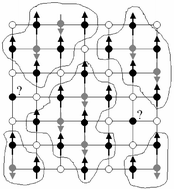Sr3Fe2UO9 double perovskite has been prepared in polycrystalline form by a solid state reaction, in air. This material has been studied by X-ray diffraction (XRD), neutron powder diffraction (NPD) and magnetic measurements. At room temperature, the crystal structure is tetragonal, space group I4/m, with a = b = 5.6994(5) Å, c = 8.039(1) Å. Its crystallographic formula can be rewritten as Sr2Fe(Fe1/3U2/3)O6, according to the usual nomenclature for double perovskites A2B′B″O6. The structure contains alternating FeO6 and (Fe,U)O6 octahedra, almost fully ordered, tilted in antiphase by 7.6° in the basal ab plane. Magnetic measurements indicate strong ferrimagnetic behaviour below TC
∼ 330 K, with a maximum magnetization of 2 μB fu−1, not fully saturated for H = 50 kOe. Ideally, the Sr3Fe2UO9 double perovskite only contains Fe3+ and U6+ cations, in such a way that superexchange interactions between neighbouring Fe3+ spins are the only nominal mechanism accounting for the magnetism of this material. At 3K, the ordered magnetic moments at Fe and (Fe,U) sites are 3.9(1) μB and −0.7(1) μB, respectively. By comparison with other members of the Sr3Fe2B″O9 double perovskite series (B″ = Mo, W), we establish a direct correlation between the degree of antisite disordering (implying the distribution of B″ over both kinds of BO6 octahedra), and the strength of the global ferromagnetic interactions, giving superior TC's and ordered magnetic moments for the most structurally disordered members.


 Please wait while we load your content...
Please wait while we load your content...